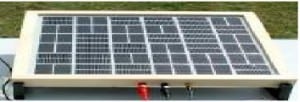
This solar cell antenna doubles as a power source for communications devices and an antenna for receiving and transmitting radio waves. Photo courtesy of Suresh Kumar
This innovation is one of our Promising Prototypes of IEEE’s Global Humanitarian Technology Conference in Seattle Oct. 30 – Nov 1. For more in the series, please see below.
Communications hardware is sometimes most useful when it is not tethered to a cord and a power grid. Cell phones are one example, as are GPS gear, communications satellites and radio receivers and transmitters in off-grid villages. These devices have to plug in occasionally, or generate their own power. In a compact device, however, power generators such as photovoltaic cells compete for space and against weight limits with the rest of the hardware.
But what if the antenna could also generate power? It turns out that solar panels can act like one half of a planar antenna (a patch antenna), to both receive and transmit electromagnetic waves (radio waves) as an antenna, and also generate power.
The planar antenna is a relative newcomer to communications technology. It has a low profile and is generally easy and cheap to make. It is basically a metallic sheet, or patch, affixed atop a larger metallic sheet as the base. The antenna continues to operate after replacing the upper sheet with solar cells, but it can also generate electricity.
Suresh Kumar and a team from Pavendar Bharathidasan College of Engineering and Technology in Tamilnadu, India, are designing highly efficient solar-powered planar antennae.
“The solar-cell antenna has mobile applications,” Kumar told E4C. “It provides energy to the circuit as well as the transmitter and receiver antenna with potential impact for the developing world,” Kumar says.
Kumar and his team tested their designs in a vehicle-mounted GPS system and an off-grid satellite radio receiver. Other applications include self-powered environmental monitoring systems and, in the future, they could fly on solar-powered autonomous atmospheric satellites.
More Promising Prototypes at GHTC:
Salinity sensors boost yields on shrimp farms
The Wound Pump can triple patients’ healing rate

